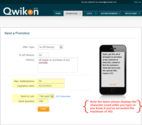-
About
- About Listly
- Community & Support
- Howto
- Chrome Extension
- Bookmarklet
- WordPress Plugin
- Listly Premium
- Privacy
- Terms
- DMCA Copyright
- © 2010-2025 Boomy Labs

Listly by Brandon Hull
Email marketing simplified Create, send and track email marketing campaigns that work. Intuitive template editor Meet the revolutionary FreshMail Designer with free email templates.

Choose from ready made templates that help convey just what you do. Edit the background color, font, texts and add custom fields for your customers to fill. It doesn't matter where you are - you can also collect email addresses while offline. When you're connected again, the data will automatically synchronize with your mailing lists in FreshMail.



Qwikon makes it quick and easy to fill in slower periods by reaching your customers anytime, anywhere, with a special offers, messages or coupons that prompt them to come see you, sometimes even in minutes.








In this installment of MarTech 101, we look at the fundamentals of Marketing Analytics.
In the pre-digital era, marketing had gained notoriety for being a cost center. Marketers would spend a lot of money on promotional activities, which were virtually untrackable. Then came the era of Digital Marketing; with the introduction of analytical tools, marketers could track each activity on their website. These tools enabled them to invest their budgets wisely and allocate their efforts and personnel to the channels that yielded the maximum Return on Investment (ROI).
In this primer, we look at the fundamentals of marketing analytics. We start by understanding the concept and the need for Marketing Analytics. Then, we look at the different attribution models and delve into the more intricate aspects of Marketing Analytics.
Table of Contents
Section I: The Fundamentals of Marketing Analytics
What is Marketing Analytics?
Why Do You Need Marketing Analytics?
What are Marketing Attribution Models?